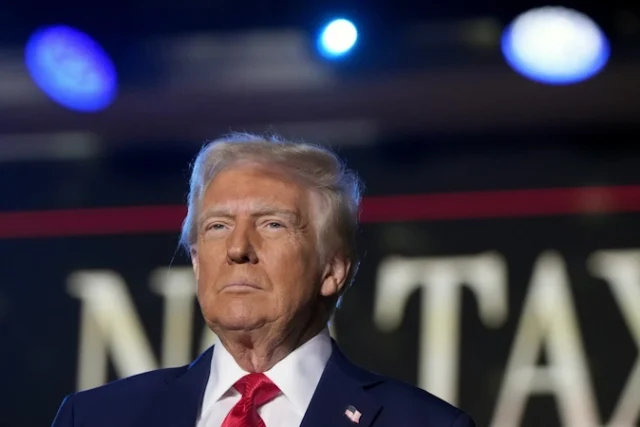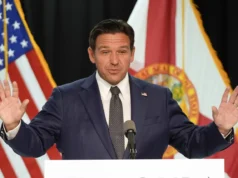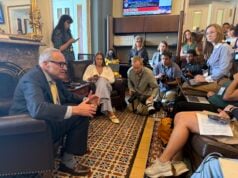
BY CHRIS MEGERIAN AND JOSH BOAK
WASHINGTON (AP) — Two months ago, in his first network television interview after the election, Donald Trump said he owed his victory to Americans’ anger over immigration and inflation, specifically the rising cost of groceries.
“When you buy apples, when you buy bacon, when you buy eggs, they would double and triple the price over a short period of time,” he told NBC’s “Meet the Press. “And I won an election based on that. We’re going to bring those prices way down.”
But in Trump’s first week back in the White House, there was little in his initial blitz of executive orders that directly tackled those prices, besides directing federal agencies to start “pursuing appropriate actions.” He is taking steps to lower energy costs, something that Trump hopes will have ripple effects throughout the economy. Otherwise, his focus has been clamping down on immigration, which he described as his “No. 1 issue” shortly after taking the oath of office.
Trump is banking on voters giving him a pass and continuing to blame former President Joe Biden for high prices. The Republican’s comments reflect the reality that presidents have almost no levers to reduce inflation quickly without causing collateral damage to other parts of the economy.
There is more that Trump can do on energy. He is pushing to reduce regulations and increase the amount of land available for drilling. He is trying to persuade domestic and foreign oil producers to potentially sacrifice their own profits by pumping more.
During a rally Saturday in Las Vegas, Trump went after his Democratic predecessor for allowing prices to rise under his watch, and promised to take care of the problem quickly.
“When I think of Biden, I think of incompetence and inflation,” Trump said.
Vice President JD Vance, in an interview with CBS’ “Face the Nation” airing Sunday, defended the White House’s work so far.
“Prices are going to come down, but it’s going to take a little bit of time, right?” he said. He added, “Rome wasn’t built in a day.”
Trump’s relative shift away from addressing costs could create an opening for Democrats to say he is not helping working-class voters, hoping that argument could offer the party a path back to power in Washington.
Sen. Chris Murphy, D-Conn., said Trump preferred to distract people from inflation with talk of adding Greenland to the United States or seizing the Panama Canal.
“It’s catnip and it causes everybody to stop paying attention to their actual economic agenda, which has nothing to do with lowering costs and everything to do with rigging the economy to help the Mar-a-Lago crowd,” he said.
“Let me get to the economy,” Hannity said at one point. “I’m running out of time.”
“The economy is going to do great,” Trump insisted.
When Trump did talk about inflation in the interview, he noted how low it was during his first term and insisted prices would not have jumped up if he had president after the 2020 election, even though higher inflation was a global trend coming out of the pandemic.
It is not clear how Trump would persuade oil companies and foreign countries to quickly increase production, possibly costing them profits.
The Energy Information Administration reported that domestic oil production has grown at an annual rate of roughly 8.4% over the past two years to an average of nearly 13.5 million barrels a day in October. Some Trump aides suggest that could increase by an additional 3 million barrels a day.
EJ Antoni, a research fellow at the Heritage Foundation, a conservative think tank in Washington, said the potential increase in energy production under Trump would ultimately flow through the economy in the form of lower prices.
But there is a risk that some of Trump’s plans taken as a whole could raise — not reduce — prices. Deporting migrants who are in the United States illegally could deprive companies of lower wage workers. The cost of tariffs, which are taxes placed on foreign imports, could be passed on to consumers.
Trump said that his strategy also might ultimately involve publicly pressuring the Federal Reserve to cut interest rates, saying in Davos that he would “demand” lower rates from central banks. The Fed sees its political independence as key for making tough choices to stabilize prices. Biden saw the independence as worth protecting, whereas Trump sees it as problematic.
The Fed raised its benchmark rates starting in 2022 to make it more expensive to borrow and succeeded enough in reducing inflationary pressures that it could trim rates late last year. Trump believes that greater oil production will put him in a position to tell the Fed what to do.
Asked in the Oval Office if he expects the Fed to listen to him, Trump simply said, “Yeah.”
Disclaimer
The information contained in South Florida Reporter is for general information purposes only.
The South Florida Reporter assumes no responsibility for errors or omissions in the contents of the Service.
In no event shall the South Florida Reporter be liable for any special, direct, indirect, consequential, or incidental damages or any damages whatsoever, whether in an action of contract, negligence or other tort, arising out of or in connection with the use of the Service or the contents of the Service. The Company reserves the right to make additions, deletions, or modifications to the contents of the Service at any time without prior notice.
The Company does not warrant that the Service is free of viruses or other harmful components
This article originally appeared here and was republished with permission.












